 |
 |
Our enthusiastic and extremely knowledgeable perennials team is here to answer your questions and help you choose the best perennials for your situation. There’s always something in bloom for sun, shade, butterflies, birds or deer resistance as well as a variety of bulbs for your space.
Stroll through our time-tested favorites and introduce yourself to the newest varieties. We garden with perennials too; we love them and it shows!
|
86 found, showing page 6 of 6
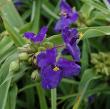
Large indigo blooms. Tolerates rabbits and moisture. Native. USDA 3-9
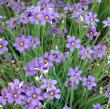
Violet blooms. Grass-like foliage. Self-seeding native. Clumping. USDA 4-8
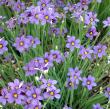
Violet blooms. Grass-like foliage. Self-seeding native. Clumping. USDA 4-8
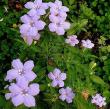
Small, lavender flowers. Dense, mounded foliage. USDA 4-8
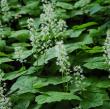
Plant Height: 6 inches
Flower Height: 12 inches
Spacing: 18 inches
Sunlight: partial shade full shade
Hardiness Zone: 3a
Ornamental Features:
Creeping Foamflower has masses of beautiful spikes of lightly-scented white star-shaped flowers rising above the foliage from mid spring to mid summer, which emerge from distinctive shell pink flower buds, and which are most effective when planted in groupings. Its lobed leaves are green in color. As an added bonus, the foliage turns a gorgeous deep purple in the fall.
Landscape Attributes:
Creeping Foamflower is an herbaceous evergreen perennial with tall flower stalks held atop a low mound of foliage. Its relatively fine texture sets it apart from other garden plants with less refined foliage.
This plant will require occasional maintenance and upkeep, and is best cleaned up in early spring before it resumes active growth for the season. Deer don't particularly care for this plant and will usually leave it alone in favor of tastier treats. Gardeners should be aware of the following characteristic(s) that may warrant special consideration: Spreading
Creeping Foamflower is recommended for the following landscape applications:
- Mass Planting
- General Garden Use
- Groundcover
Planting & Growing:
Creeping Foamflower will grow to be only 6 inches tall at maturity extending to 12 inches tall with the flowers, with a spread of 24 inches. When grown in masses or used as a bedding plant, individual plants should be spaced approximately 18 inches apart. Its foliage tends to remain low and dense right to the ground. It grows at a fast rate, and under ideal conditions can be expected to live for approximately 10 years. As an evegreen perennial, this plant will typically keep its form and foliage year-round.
This plant does best in partial shade to shade. It requires an evenly moist well-drained soil for optimal growth. It is particular about its soil conditions, with a strong preference for rich, acidic soils. It is somewhat tolerant of urban pollution, and will benefit from being planted in a relatively sheltered location. Consider covering it with a thick layer of mulch in winter to protect it in exposed locations or colder microclimates. This species is native to parts of North America. It can be propagated by division.
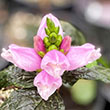
Height: 3 feet
Spread: 3 feet
Sunlight: full sun partial shade
Hardiness Zone: 4a
Other Names: Lyon's Turtlehead, Shellflower
Description:
Lush deep-green, shiny leaves topped with hot rosey-pink flowers which are shaped like little turtle heads; tolerant to moisture, this spreading plant is fantastic for stream edges and in bog gardens
Ornamental Features:
Hot Lips Turtlehead has masses of beautiful hot pink hooded flowers at the ends of the stems from late summer to mid fall, which are most effective when planted in groupings. The flowers are excellent for cutting. Its glossy pointy leaves remain dark green in color throughout the season.
Landscape Attributes:
Hot Lips Turtlehead is a dense herbaceous perennial with an upright spreading habit of growth. Its medium texture blends into the garden, but can always be balanced by a couple of finer or coarser plants for an effective composition.
This plant will require occasional maintenance and upkeep, and is best cleaned up in early spring before it resumes active growth for the season. Gardeners should be aware of the following characteristic(s) that may warrant special consideration: Spreading
Hot Lips Turtlehead is recommended for the following landscape applications:
- Mass Planting
- General Garden Use
- Naturalizing And Woodland Gardens
- Bog Gardens
Planting & Growing:
Hot Lips Turtlehead will grow to be about 3 feet tall at maturity, with a spread of 3 feet. Its foliage tends to remain dense right to the ground, not requiring facer plants in front. It grows at a medium rate, and under ideal conditions can be expected to live for approximately 12 years. As an herbaceous perennial, this plant will usually die back to the crown each winter, and will regrow from the base each spring. Be careful not to disturb the crown in late winter when it may not be readily seen!
This plant does best in full sun to partial shade. It prefers to grow in moist to wet soil, and will even tolerate some standing water. It is not particular as to soil pH, but grows best in rich soils. It is somewhat tolerant of urban pollution. Consider applying a thick mulch around the root zone over the growing season to conserve soil moisture. This is a selection of a native North American species. It can be propagated by division; however, as a cultivated variety, be aware that it may be subject to certain restrictions or prohibitions on propagation.
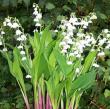
Plants form a spreading clump of large green leaves, bearing short spikes of fragrant white bells in late spring. Takes a year or two to establish, then spreads quickly. USDA 3-8
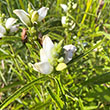
Height: 3 feet
Spread: 30 inches
Sunlight: full sun partial shade
Hardiness Zone: 3a
Other Names: Shellflower
Description:
The white hooded flowers on this perennial make it a great addition to the garden; thrives in wet or moist areas; attracts butterflies
Ornamental Features:
Turtlehead has masses of beautiful white hooded flowers with shell pink overtones at the ends of the stems from late summer to mid fall, which are most effective when planted in groupings. The flowers are excellent for cutting. Its serrated pointy leaves remain dark green in color throughout the season.
Landscape Attributes:
Turtlehead is a dense herbaceous perennial with an upright spreading habit of growth. Its medium texture blends into the garden, but can always be balanced by a couple of finer or coarser plants for an effective composition.
This plant will require occasional maintenance and upkeep, and is best cleaned up in early spring before it resumes active growth for the season. Gardeners should be aware of the following characteristic(s) that may warrant special consideration: Spreading
Turtlehead is recommended for the following landscape applications:
- Mass Planting
- General Garden Use
- Naturalizing And Woodland Gardens
- Bog Gardens
Planting & Growing:
Turtlehead will grow to be about 3 feet tall at maturity, with a spread of 30 inches. Its foliage tends to remain dense right to the ground, not requiring facer plants in front. It grows at a medium rate, and under ideal conditions can be expected to live for approximately 12 years. As an herbaceous perennial, this plant will usually die back to the crown each winter, and will regrow from the base each spring. Be careful not to disturb the crown in late winter when it may not be readily seen!
This plant does best in full sun to partial shade. It is quite adaptable, prefering to grow in average to wet conditions, and will even tolerate some standing water. It is not particular as to soil pH, but grows best in rich soils. It is somewhat tolerant of urban pollution. Consider applying a thick mulch around the root zone over the growing season to conserve soil moisture. This species is native to parts of North America. It can be propagated by division.
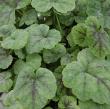
White blooms. Red speckled foliage. Groundcover. Native. USDA 4-8
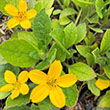
Showy yellow blooms spring through summer. Clumping groundcover. Prefers moist soils. Native. USDA 5-9
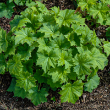
Plant Height: 24 inches
Flower Height: 3 feet
Spacing: 20 inches
Sunlight: full sun partial shade full shade
Hardiness Zone: 4a
Other Names: Maple Leaf Alumroot, Coralbells
Description:
Airy spikes of creamy bells rise from a large, dense mound of cup shaped, ruffled green foliage, great versatility; keep soil moist in heat of summer
Ornamental Features:
Autumn Bride Hairy Alumroot features showy spikes of creamy white bell-shaped flowers rising above the foliage in mid summer. Its attractive large crinkled lobed leaves remain green in color throughout the year.
Landscape Attributes:
Autumn Bride Hairy Alumroot is a dense herbaceous evergreen perennial with tall flower stalks held atop a low mound of foliage. Its relatively fine texture sets it apart from other garden plants with less refined foliage.
This is a relatively low maintenance plant, and should be cut back in late fall in preparation for winter. It is a good choice for attracting hummingbirds to your yard. It has no significant negative characteristics.
Autumn Bride Hairy Alumroot is recommended for the following landscape applications:
- Mass Planting
- Rock/Alpine Gardens
- Border Edging
- General Garden Use
- Groundcover
- Container Planting
- Planting & Growing
Autumn Bride Hairy Alumroot will grow to be about 24 inches tall at maturity extending to 3 feet tall with the flowers, with a spread of 24 inches. When grown in masses or used as a bedding plant, individual plants should be spaced approximately 20 inches apart. Its foliage tends to remain dense right to the ground, not requiring facer plants in front. It grows at a medium rate, and under ideal conditions can be expected to live for approximately 10 years. As an evegreen perennial, this plant will typically keep its form and foliage year-round.
This plant performs well in both full sun and full shade. However, you may want to keep it away from hot, dry locations that receive direct afternoon sun or which get reflected sunlight, such as against the south side of a white wall. It prefers to grow in average to moist conditions, and shouldn't be allowed to dry out. It is not particular as to soil type or pH. It is somewhat tolerant of urban pollution. Consider applying a thick mulch around the root zone in winter to protect it in exposed locations or colder microclimates. This is a selection of a native North American species. It can be propagated by division; however, as a cultivated variety, be aware that it may be subject to certain restrictions or prohibitions on propagation.
Autumn Bride Hairy Alumroot is a fine choice for the garden, but it is also a good selection for planting in outdoor pots and containers. With its upright habit of growth, it is best suited for use as a 'thriller' in the 'spiller-thriller-filler' container combination; plant it near the center of the pot, surrounded by smaller plants and those that spill over the edges. It is even sizeable enough that it can be grown alone in a suitable container. Note that when growing plants in outdoor containers and baskets, they may require more frequent waterings than they would in the yard or garden.
86 found, showing page 6 of 6




